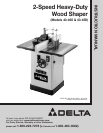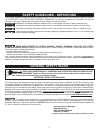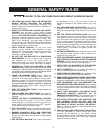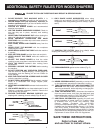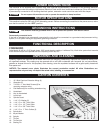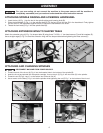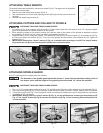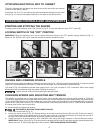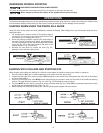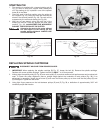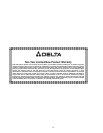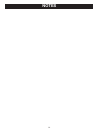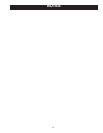
10
POSITION OF COLLARS
1. The collars may be used in any of three positions:
above, below, or between two cutters.
2. When the collar is used below the cutter (Fig. 29), the
operator can see the progress of the cut. NOTE: Any
accidental lifting of the work will gouge the wood and
ruin the workpiece.
3. When the collar is used above the cutter (Fig. 29), the
operator will be unable to see the cut. However, the
advantage in this method is that the cut is not affected
by slight variations in the thickness of the stock. Also, accidental lifting of the work will not gouge the workpiece. Simple
correction for the mistake is to repeat the operation.
4. The collar between cutters method (Fig. 30) utilizes the advantages of the first two methods and is frequently used when
both edges of the workpiece are to be shaped.
END SHAPING
Maintain sufficient support of the workpiece during all shaping operations. USE A MITER GAUGE OR BACK-UP BLOCK
(Figs. 31 and 32) when end shaping a workpiece that is too short to be sufficiently supported halfway through the cut.
Shaping a narrow workpiece without sufficient support could result in serious injury.
The infeed fence assembly must be parallel to the miter slot when using the miter gauge. Adjust the outfeed fence so that it
will not contact the workpiece after it has passed the cutter. Place the workpiece firmly against the miter gauge and the infeed
fence, and feed the cutter by pushing the miter gauge.
Failure to hold the workpiece firmly against the miter gauge during the cut could result in slippage of
the workpiece, causing serious personal injury and/or damage to the workpiece.
CROSS GRAIN SHAPING
Shaping across the grain will usually cause some splitting at the end of the cut. Feeding the workpiece slowly across the
cutter at the end of the cut can minimize the splitting. Shape the cross-grain cuts first. Shaping with the grain last will usually
remove the splintered end.
SHAPING NARROW MATERIAL
Clamp a support (Fig. 33) to the machine when shaping narrow material (less than 3" wide) Feed the workpiece under this
support with a push stick. NOTE: The push stick should be slightly narrower and thinner than the workpiece.
Shaping narrow material without proper support and push stick could result in serious injury.
Fig. 31
Fig. 32
Fig. 33
BACK-UP BLOCK
Warning:
Keep Hands
Away from Cutter
Warning:
Keep Hands
Away from Cutter
MITER GAUGE
PUSH STICK
Slightly narrower and
thinner than workpiece
WORK SUPPORT
WORKPIECE
WARNING;
KEEP HANDS
AWAY FROM
CUTTER
Fig. 29
Fig. 30
Fig. 28



